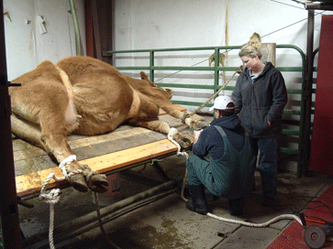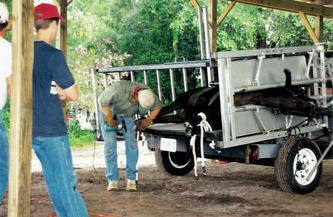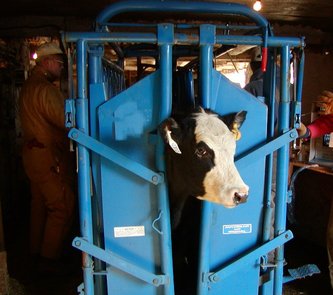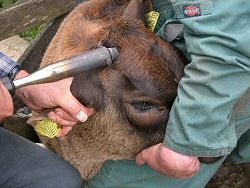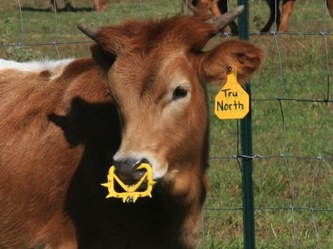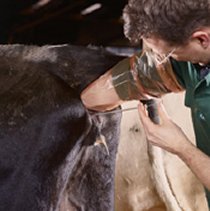Articles For Consumers
This page includes articles that consumers can use to educate themselves about the cattle industry. If you would like to see a topic covered that isn't, or make an addition to an article, please send an e-mail.
What's Really Happening?
Perhaps you've seen instances such as ones depicted in the below pictures. If you aren't someone who has been around animals much, you may not know what you are seeing-maybe even thinking that there is some sort of abuse going on. In fact, many procedures like the ones below are done to benefit the animal! Roll your mouse over each photo or click to enlarge and read about what is really happening.
Are You Ready To Own A Cow?
by Kassandre Moulton
based on the work of David Randall
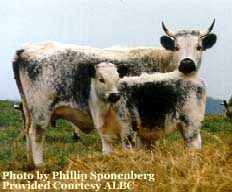
Perhaps you are considering taking up hobby farming, or maybe getting a family milk cow. While cows are fairly simple to maintain, they do have certain requirements that need to be met. Before you take your first foray into cattle ownership, consider the following checklist, adapted from “Are You Ready To Own A Randall Lineback?” by David Randall.
1. Do you own enough land?
If you plan on pasturing your cow, she will likely need to have 3-5 acres to utilize during the warm season. You also need to have land that is suitable for a cow’s needs; if your land is muddy it will become an even bigger mess in a short time.
2. Do you have a reliable feed source?
Even if you plan on making your own feed, make sure you have an alternate source. Running out of hay in the middle of winter is not a good thing.
3. Do you have an adequate shelter?
Cattle are pretty hardy and don’t usually mind the rain or snow. However, they do need a place to get out of the wind, sun, and extreme cold. A three sided shelter is usually adequate, just make sure it has a dry floor and is kept clean.
4. Do you have an adequate water source?
Cows that are lactating can drink over forty gallons a day. I have found that even in the middle of winter when my beef cows are dry, they drink over five gallons apiece. Don’t rely on a pond to be a water source, it usually isn’t very clean (On another note, it usually isn’t wise to give your cattle access to a pond. They often relieve themselves in the water, and then wade in it, resulting in nasty mastitis bacteria finding their way into the udder; or they may get stuck and drown). Keep in mind that if you live where temperatures reach freezing in the winter, you will have to make sure your water supply doesn’t freeze. Insulating the area around your water pipes/hoses or using a heat lamp or heater can make a big difference. You can also buy heating systems for tubs. A cow that has recently calved will need some warm water, and a lot of it, so make sure you are able to provide it.
5. Do you have a waste management plan?
Even one cow can produce a lot of waste. Make sure you have a place to store the waste where it will not run off. You can compost the manure if you have space for a large pile, or find a place to spread it.
6. Do you have a large animal vet who will be willing to work with you?
Emergencies happen. Make sure you have a vet who can be there for you. In some states, certain vaccinations must be done by a vet and/or certain medications have to be purchased from a vet as well.
7. Do you have a health plan for your cow?
Find out what vaccinations are recommended for your area.
8. Do you plan on milking her?
If you are looking for a family milk cow, you might want to consider a dual-purpose breed rather than a dairy breed like a Holstein. Holsteins can produce over a hundred pounds of milk a day at their peak! A dual purpose breed such as a Randall Lineback or a Dexter will produce a good amount of milk for family use. Many dual-purpose breeds are endangered, so you would also be helping to preserve the breed. However, this should be seen as a responsibility-what you choose to do with your animal could have a big impact. Hand milking is a learned skill. You will also need to follow a cleanliness routine. If you plan on pasteurizing your milk, that is another expense. The cow will need to be milked once or twice a day every day depending on her production. Make sure you have time to do this, and that you have someone who can milk for you when you have other obligations.
9. How are you going to breed her?
In order for her to keep producing milk, you cow will need to have a calf every year. Owning a bull is not a good idea, they can get very large and they are always unpredictable. A.I. is usually your best bet. You will need to find a service that operates in your area, and you’ll need to learn the signs of heat so your cow can be bred at the proper time. You can learn to do A.I. youself and own your own semen tank, but A.I. is a skill that requires lots of practice. Semen tanks must be refilled with liquid nitrogen periodically.
As with any other pet or livestock, keep in mind that your cow can live for a long time-you must be ready to accept that responsibility. Before you take the plunge, it may be a good idea to talk with other cattlemen in your area-you can learn a lot! They can share valuable info on their experiences that you can use to make your decision. Your local cooperative extension is also a great resource.
1. Do you own enough land?
If you plan on pasturing your cow, she will likely need to have 3-5 acres to utilize during the warm season. You also need to have land that is suitable for a cow’s needs; if your land is muddy it will become an even bigger mess in a short time.
2. Do you have a reliable feed source?
Even if you plan on making your own feed, make sure you have an alternate source. Running out of hay in the middle of winter is not a good thing.
3. Do you have an adequate shelter?
Cattle are pretty hardy and don’t usually mind the rain or snow. However, they do need a place to get out of the wind, sun, and extreme cold. A three sided shelter is usually adequate, just make sure it has a dry floor and is kept clean.
4. Do you have an adequate water source?
Cows that are lactating can drink over forty gallons a day. I have found that even in the middle of winter when my beef cows are dry, they drink over five gallons apiece. Don’t rely on a pond to be a water source, it usually isn’t very clean (On another note, it usually isn’t wise to give your cattle access to a pond. They often relieve themselves in the water, and then wade in it, resulting in nasty mastitis bacteria finding their way into the udder; or they may get stuck and drown). Keep in mind that if you live where temperatures reach freezing in the winter, you will have to make sure your water supply doesn’t freeze. Insulating the area around your water pipes/hoses or using a heat lamp or heater can make a big difference. You can also buy heating systems for tubs. A cow that has recently calved will need some warm water, and a lot of it, so make sure you are able to provide it.
5. Do you have a waste management plan?
Even one cow can produce a lot of waste. Make sure you have a place to store the waste where it will not run off. You can compost the manure if you have space for a large pile, or find a place to spread it.
6. Do you have a large animal vet who will be willing to work with you?
Emergencies happen. Make sure you have a vet who can be there for you. In some states, certain vaccinations must be done by a vet and/or certain medications have to be purchased from a vet as well.
7. Do you have a health plan for your cow?
Find out what vaccinations are recommended for your area.
8. Do you plan on milking her?
If you are looking for a family milk cow, you might want to consider a dual-purpose breed rather than a dairy breed like a Holstein. Holsteins can produce over a hundred pounds of milk a day at their peak! A dual purpose breed such as a Randall Lineback or a Dexter will produce a good amount of milk for family use. Many dual-purpose breeds are endangered, so you would also be helping to preserve the breed. However, this should be seen as a responsibility-what you choose to do with your animal could have a big impact. Hand milking is a learned skill. You will also need to follow a cleanliness routine. If you plan on pasteurizing your milk, that is another expense. The cow will need to be milked once or twice a day every day depending on her production. Make sure you have time to do this, and that you have someone who can milk for you when you have other obligations.
9. How are you going to breed her?
In order for her to keep producing milk, you cow will need to have a calf every year. Owning a bull is not a good idea, they can get very large and they are always unpredictable. A.I. is usually your best bet. You will need to find a service that operates in your area, and you’ll need to learn the signs of heat so your cow can be bred at the proper time. You can learn to do A.I. youself and own your own semen tank, but A.I. is a skill that requires lots of practice. Semen tanks must be refilled with liquid nitrogen periodically.
As with any other pet or livestock, keep in mind that your cow can live for a long time-you must be ready to accept that responsibility. Before you take the plunge, it may be a good idea to talk with other cattlemen in your area-you can learn a lot! They can share valuable info on their experiences that you can use to make your decision. Your local cooperative extension is also a great resource.
The Pasteurized Milk Ordinance
by Kassandre Moulton
In order for their milk to be considered Grade A milk and be sold in stores, producers must meet a strict set of food safety guidelines called the Pasteurized Milk Ordinance, or PMO. The PMO is a set of federal laws developed by the FDA in conjunction with the National Conference On Interstate Milk Shipments, with public health goals in mind. The PMO includes standards for quality sampling and testing, cleanliness, drug usage and storage, milkhouse and parlor design, equipment and utensils, and more. Grade A milk is tested regularly for bacteria (limited by the PMO), drug or antibiotic residues (residue tests must come up negative), and is subject to strict temperature regulations. The milk must be cooled to fifty degrees F or less within four hours of the start of milking. It must be cooled to 45 degrees F or less within two hours after milking is completed. After this point, the blended milk temperature cannot exceed 50 degrees. Each time the milk is picked up by the processor, samples are taken from the farm’s bulk tank. Before the milk is processed, the milk is tested to see that it meets PMO standards. If not, it will not be sold. Farms are also inspected twice a year to check the welfare of the cows, cleanliness of the farm, and to see that the equipment and water supply meet federal standards. The consumer can take comfort that farmers care about the quality of their milk, in turn keeping it safe and flavorful by the time it reaches your fridge.
Cattle Products-Everywhere You Look!
Cattle produce a lot of things that we use every day-not just milk and meat!
Products from bone & horns:
bone china ice cream piano keys
candies knife handles vitamin capsules
chewing gum lipstick wallpaper paste
combs photo film
Products from hide & hair:
baseball gloves car upholstery drum heads
leather clothing violin strings shoes
felt hats luggage wallets
watch bands belts softballs & baseballs
rawhide
Products from glands & organs:
asphalt cosmetics fertilizer
insulation medicines paint
plastic soap tires
source: Oregon State University
Products from bone & horns:
bone china ice cream piano keys
candies knife handles vitamin capsules
chewing gum lipstick wallpaper paste
combs photo film
Products from hide & hair:
baseball gloves car upholstery drum heads
leather clothing violin strings shoes
felt hats luggage wallets
watch bands belts softballs & baseballs
rawhide
Products from glands & organs:
asphalt cosmetics fertilizer
insulation medicines paint
plastic soap tires
source: Oregon State University
The History of Dairying
by Kassandre Moulton
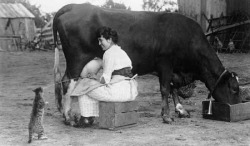
photo c. Colorado Agricultural College
Dairy cattle and milk have been part of the human experience for thousands of years. Milk is often called “nature’s most perfect food” and for good reason. Milk is easy to harvest, high in protein, calcium and other nutrients; and is easy to sample and tests. Cows have a great ability to convert many types of feed into high quality milk. Dairying is thought to have begun in Mesopotamia between 6000 – 8000 B.C. The first written record of dairying has been dated to about 6000 B.C. Dairying was depicted in Sumerian mosaics in 3100 B.C. The first record of butter and cheese production dated to 3000 B.C. in Egypt. Cheeses became an important part of the Greek and Roman diet around 1000 B.C. as they discovered effective ways to store and preserve it. Milk is even mentioned in the Bible (“the land of milk and honey”). By the 8th century, dairy products had become a mainstay in the human diet in places like Scandinavia.
Cattle were first brought to the United States in the 1600’s. Producers began selecting for traits and further developing the breeds we know today. 1851 brought the opening of the first U.S. cheese plant, and five years later, a patent was awarded for condensed milk. The first breed association was created in 1860 when Maine Jersey breeders came together to form it. That year also brought the science of pasteurization, making milk safer for many people. In 1871, the first cream separator was invented by DeLaval. Hoard’s Dairyman, a magazine still being published today, put out its first issue in 1885. In 1903 a new breakthrough came with the invention of the milking machine by Alex Giles of Australia. The electrification of rural areas in the 1930’s allowed many farmers to utilize this technology on their farms.
As you can see, modern dairying has a deep history. Many of the breakthroughs throughout this history are still in use today and are continually improved. Dairy farming is constantly moving forward to make sure cow care is optimum, practices are efficient, and the products are of supreme quality.
Cattle were first brought to the United States in the 1600’s. Producers began selecting for traits and further developing the breeds we know today. 1851 brought the opening of the first U.S. cheese plant, and five years later, a patent was awarded for condensed milk. The first breed association was created in 1860 when Maine Jersey breeders came together to form it. That year also brought the science of pasteurization, making milk safer for many people. In 1871, the first cream separator was invented by DeLaval. Hoard’s Dairyman, a magazine still being published today, put out its first issue in 1885. In 1903 a new breakthrough came with the invention of the milking machine by Alex Giles of Australia. The electrification of rural areas in the 1930’s allowed many farmers to utilize this technology on their farms.
As you can see, modern dairying has a deep history. Many of the breakthroughs throughout this history are still in use today and are continually improved. Dairy farming is constantly moving forward to make sure cow care is optimum, practices are efficient, and the products are of supreme quality.
USDA Meat Labeling Terms
by Kassandre Moulton
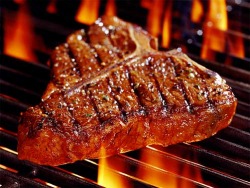
Buying beef at the grocery store can be very confusing. Not only are their different cuts, but different grades and labels. What does it all mean? This list of terms from the USDA's Food Safety & inspection Service site will help you decode beef labels.
-NATURAL : A product containing no artificial ingredients or added coloring, with minimal processing. The label must also explain why the meat is natural (i.e. "no added colorings").
-NO HORMONES: Producers may use this label if they provide sufficient evidence that no hormones were used in raising the cattle.
-NO ANTIBIOTICS: The producer must supply evidence that no antibiotics were used in the raising of the animal.
-ORGANIC: Denotes that the beef was produced in accordance to The Organic Foods Production Act. Farms must be inspected and certified in order to sell as "certified organic".
-CERTIFIED: This label implies that the USDA has officially inspected the meat for quality characteristics (i.e. Certified Angus Beef).
For more information, including labels for other types of meat, visit the following site:
http://www.fsis.usda.gov/FactSheets/Meat_&_Poultry_Labeling_Terms/index.asp
-NATURAL : A product containing no artificial ingredients or added coloring, with minimal processing. The label must also explain why the meat is natural (i.e. "no added colorings").
-NO HORMONES: Producers may use this label if they provide sufficient evidence that no hormones were used in raising the cattle.
-NO ANTIBIOTICS: The producer must supply evidence that no antibiotics were used in the raising of the animal.
-ORGANIC: Denotes that the beef was produced in accordance to The Organic Foods Production Act. Farms must be inspected and certified in order to sell as "certified organic".
-CERTIFIED: This label implies that the USDA has officially inspected the meat for quality characteristics (i.e. Certified Angus Beef).
For more information, including labels for other types of meat, visit the following site:
http://www.fsis.usda.gov/FactSheets/Meat_&_Poultry_Labeling_Terms/index.asp
How Do You Milk A Cow?
by Kassandre Moulton
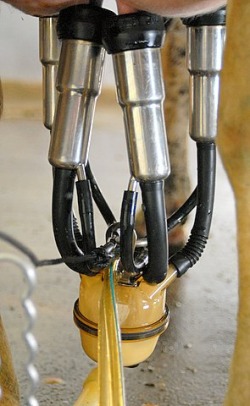
a milking machine attached to a cow's udder
Milking procedures vary by farm and equipment. There are two main types of milking systems, a tie stall operation and a parlor system. There are several types of parlors to take into account as well. However, the basic procedure is similar across the board. Milking systems are complex and again, vary by operation, but there are basic similarities we can look at.
Systems are powered by a vacuum pump. It generates the power that removes and moves the milk. Vacuum pumps come in different sizes and can be adjusted and regulated to control the milking machines. Milking machines are attached to the cow, with one teat going into each of the four cups. Milk travels from the individual unit to a pipeline, where it then heads to a receiving jar. Then it is filtered and pumped into the bulk tank. The bulk tank is temperature regulated and holds the milk until a truck comes to take it to the processor. Milking consists of a rest phase, during which the teats are squeezed, and the milk phase, when the pressure from the vacuum is released and milk comes down.
Before a unit is attached, though, there is a sanitation procedure that must be followed by milking personnel (again, these may vary). The first step is to let the cow know that the milker is there so that they do not spook. Milkers wear gloves and sometimes aprons to prevent the transmission of germs from themselves to the cow. Using a gloved hand or clean paper or cloth towel, the milker removes any dry material from the udder and teats, such as bedding. Then, each teat is “stripped” so that the milker can make sure the milk looks normal and that there are no problems. This step also stimulates the release of oxytocin, the hormone that the cow uses to “let down” her milk. The teats are then dipped or sprayed with a pre-dip solution, a sanitizer that is often made up of iodine. The milker must make sure that the teats are covered uniformly and that contact time is 20-30 seconds. The teats are then dried with a clean towel. The milking machine is then attached, and must be monitored in case the cow kicks at it or a cup liner slips. When the cow is finished milking, her udder will be slack and pliable, and the milker knows to remove the machine. It is important to shut off the vacuum to the individual machine before removal. The udder is then post-dipped with a thicker solution that removes milk on the teat, kills bacteria, and forms a barrier to keep the teats as clean as possible.
Systems are powered by a vacuum pump. It generates the power that removes and moves the milk. Vacuum pumps come in different sizes and can be adjusted and regulated to control the milking machines. Milking machines are attached to the cow, with one teat going into each of the four cups. Milk travels from the individual unit to a pipeline, where it then heads to a receiving jar. Then it is filtered and pumped into the bulk tank. The bulk tank is temperature regulated and holds the milk until a truck comes to take it to the processor. Milking consists of a rest phase, during which the teats are squeezed, and the milk phase, when the pressure from the vacuum is released and milk comes down.
Before a unit is attached, though, there is a sanitation procedure that must be followed by milking personnel (again, these may vary). The first step is to let the cow know that the milker is there so that they do not spook. Milkers wear gloves and sometimes aprons to prevent the transmission of germs from themselves to the cow. Using a gloved hand or clean paper or cloth towel, the milker removes any dry material from the udder and teats, such as bedding. Then, each teat is “stripped” so that the milker can make sure the milk looks normal and that there are no problems. This step also stimulates the release of oxytocin, the hormone that the cow uses to “let down” her milk. The teats are then dipped or sprayed with a pre-dip solution, a sanitizer that is often made up of iodine. The milker must make sure that the teats are covered uniformly and that contact time is 20-30 seconds. The teats are then dried with a clean towel. The milking machine is then attached, and must be monitored in case the cow kicks at it or a cup liner slips. When the cow is finished milking, her udder will be slack and pliable, and the milker knows to remove the machine. It is important to shut off the vacuum to the individual machine before removal. The udder is then post-dipped with a thicker solution that removes milk on the teat, kills bacteria, and forms a barrier to keep the teats as clean as possible.
Cattle Terms
by Kassandre Moulton
Following you will find terminology definitions for a variety of words used in the beef and dairy cattle industries. If you would like to add something to a definition, dispute a description, or suggest a word, please contact me at [email protected]
Basics
· Breed: A type of animal with distinct characteristics and common origin. i.e. Angus.
· Bull : Male bovine
· Calf: A baby bovine.
· Confirmation: The shape of an animal’s body parts.
· Cow: A female bovine that has had a calf.
· Dam: Female parent
· Freemartin: Infertile female.
· Heat: Estrus
· Heifer: A female bovine that has not yet given birth.
· Lactation: Period of milk production.
· Sire: Male parent
· Steer: Castrated male bovine
Production
· Butterfat: The naturally occurring fat content of milk. Milk is usually sold in the store by how much fat it contains.
· Dry: A cow that is not currently producing milk.
Management
· Branding: Applying an identifying mark to cattle using a hot or cold iron.
· Commercial Production: Producing cattle with a focus on beef production rather than breeding stock.
· Culling: Removing less desirable animals from a herd.
· Dehorning: Removing horns from an animal. In cattle, it can be done with a number of tools, including a hot iron, caustic paste, scoop tools or saws. Usually a quick and relatively painless procedure if done at a young age and by an experienced handler.
· Ear Tag: A tag that is attached to an ear for identification using a piercing tool, similar to a human earring.
· Embryo Transfer: Flushing fertilized embryos from a donor cow and placing them in a recipient animal. Allows a breeder to produce more high quality animals than naturally possible.
· Feed Efficiency: Units of feed consumed per unit of gain (whether gain of weight or production).
· Marbling: Specks of fat distributed into intramuscular tissue.
· Pedigree: Tabulation of an individual’s ancestors.
· Progeny: Offspring
· Purebred: Animal with known ancestry within a recognized breed.
Record Keeping
· Body Condition Score (BCS): Used in assessing the amount of body fat on cattle. Score is assessed on a 1-9 scale when dealing with beef cattle and 1-5 for dairy cattle, with one being the thinnest in both cases.
· EPD: Expected Progeny Difference- The expected differences in performance of a sire’s progeny when compared to the average progeny of all sires evaluated within the breed. Based on actual performance, progeny performance, and relatives’ performance
Breeding
· Artificial Insemination: Placing semen from a bull into a cow using means other than natural service. Usually involves using frozen semen and a pipette. Allows for cows to be bred to outstanding bulls that a farmer might not be able to access for natural service
· Calving Ease: The ease with which a cow gives birth, often depends on the size of the calf and condition of the cow.
· Cross Breeding: mating two animals of different breeds.
· Dilution Gene: Cattle carrying the dilution gene will be gray, red, or yellow. Non-diluted cattle will be black or dark red.
· Heterosis/Hybrid Vigor: Amount by which a crossbred animal outperforms a purebred animal.
· Heterozygous Black: Black bulls that carry one red gene. Expect 50% black calves when bull is mated to undiluted red cows.
· Homozygous Black: Bulls with a 99.9% probability of producing all black calves when mated to non-diluted red or black cows.
Basics
· Breed: A type of animal with distinct characteristics and common origin. i.e. Angus.
· Bull : Male bovine
· Calf: A baby bovine.
· Confirmation: The shape of an animal’s body parts.
· Cow: A female bovine that has had a calf.
· Dam: Female parent
· Freemartin: Infertile female.
· Heat: Estrus
· Heifer: A female bovine that has not yet given birth.
· Lactation: Period of milk production.
· Sire: Male parent
· Steer: Castrated male bovine
Production
· Butterfat: The naturally occurring fat content of milk. Milk is usually sold in the store by how much fat it contains.
· Dry: A cow that is not currently producing milk.
Management
· Branding: Applying an identifying mark to cattle using a hot or cold iron.
· Commercial Production: Producing cattle with a focus on beef production rather than breeding stock.
· Culling: Removing less desirable animals from a herd.
· Dehorning: Removing horns from an animal. In cattle, it can be done with a number of tools, including a hot iron, caustic paste, scoop tools or saws. Usually a quick and relatively painless procedure if done at a young age and by an experienced handler.
· Ear Tag: A tag that is attached to an ear for identification using a piercing tool, similar to a human earring.
· Embryo Transfer: Flushing fertilized embryos from a donor cow and placing them in a recipient animal. Allows a breeder to produce more high quality animals than naturally possible.
· Feed Efficiency: Units of feed consumed per unit of gain (whether gain of weight or production).
· Marbling: Specks of fat distributed into intramuscular tissue.
· Pedigree: Tabulation of an individual’s ancestors.
· Progeny: Offspring
· Purebred: Animal with known ancestry within a recognized breed.
Record Keeping
· Body Condition Score (BCS): Used in assessing the amount of body fat on cattle. Score is assessed on a 1-9 scale when dealing with beef cattle and 1-5 for dairy cattle, with one being the thinnest in both cases.
· EPD: Expected Progeny Difference- The expected differences in performance of a sire’s progeny when compared to the average progeny of all sires evaluated within the breed. Based on actual performance, progeny performance, and relatives’ performance
Breeding
· Artificial Insemination: Placing semen from a bull into a cow using means other than natural service. Usually involves using frozen semen and a pipette. Allows for cows to be bred to outstanding bulls that a farmer might not be able to access for natural service
· Calving Ease: The ease with which a cow gives birth, often depends on the size of the calf and condition of the cow.
· Cross Breeding: mating two animals of different breeds.
· Dilution Gene: Cattle carrying the dilution gene will be gray, red, or yellow. Non-diluted cattle will be black or dark red.
· Heterosis/Hybrid Vigor: Amount by which a crossbred animal outperforms a purebred animal.
· Heterozygous Black: Black bulls that carry one red gene. Expect 50% black calves when bull is mated to undiluted red cows.
· Homozygous Black: Bulls with a 99.9% probability of producing all black calves when mated to non-diluted red or black cows.
Dairy Breeds
by Kassandre Moulton
Cattle breeds are split into groups based on their purpose. In this article you will read about the main breeds of dairy cattle (and some that are rarer) present in the United States today. These cattle are used for milk production, whether as a family cow or as part of a 1,000 cow herd.
MAJOR BREEDS:
AYRSHIRE
These hardy cattle originated in Scotland. They are red and white, with the red varying from a mahogany color to a bright red. Ayrshires are a medium sized breed, with cows weighing about 1,200 pounds at maturity. These are rugged cattle that do very well on pasture. The average Ayrshire will produce about 17,000 pounds of milk throughout a single lactation. The butterfat content of the milk is at about 3.9%. Ayrshires are not as popular as they once were, and are currently on the “watch” list of the American Livestock Breeds Conservancy.
BROWN SWISS
Brown Swiss cattle were first introduced to the United States from Switzerland in 1869 and are considered to be one of the oldest dairy breeds worldwide. These cattle are grayish-brown with a dark muzzle. They are a vigorous breed that can adapt to almost any climate.
GUERNSEY
Guernseys originate from the small Isle of Guernsey in the English Channel. They are gentle, small, and delicate cattle that are fawn and white in color. Their milk is prized for its high butterfat content (4.5%) and the average cow will produce close to 15,000 lbs a year. The milk is golden in color, due to a high beta carotene content, which led to the breed’s nickname of “Golden Guernsey”. The breed is currently on the “watch” list of the American Livestock Breeds Conservancy.
HOLSTEIN
The Holstein, or Holstein-Fresian, are the most popular dairy breed in the United States today. They may be black and white or red and white. They produce the most milk of any breed, averaging about 28,000 pounds a year. Their milk has moderate butterfat and protein levels. A mature Holstein cow will on average weigh about 1,500 pounds.
JERSEY
Jerseys are the smallest of the major breeds and range in color from brown to fawn, darkening around the facial features. Some have white markings as well. They are the second most popular dairy breed due to their milk’s high butterfat content (about 5%) and their feed efficiency. The average Jersey makes about 16,000 pounds of milk per lactation. They were developed on the English Isle of Jersey.
MILKING SHORTHORN
These cattle are descendants of the beef shorthorn breed. They are often “beefier” in appearance than the other dairy breeds. They can be dark red, dark red and white, white, or roan. Their production can be compared to that of a Guernsey, though their butterfat levels are lower.
RARER BREEDS
RANDALL LINEBACK
These cattle originated in Vermont. They give less milk than a typical dairy breed which makes them ideal for a homestead or family cow. They are of moderate size and can be easily recognized by the white line that runs down their back. They have dark sides, muzzle, eyes, ears, and legs, usually blue-black in color. There are only about 300 of these cattle in the world. They are designated as “critical” by the American Livestock Breeds Conservancy.
DUTCH BELTED
These “oreo” cows are not to be confused with the Belted Galloway, a beef breed. They are black or red with a white belt around the middle of the barrel. They are of moderate size and are good grazers. They are considered “critical” by the American Livestock Breeds Conservancy. These cattle show exceptional longevity, with many cows in their teens still producing.
Sources: Oklahoma State University, American Livestock Breeds Conservancy, Brown Swiss Association, Raw Milk Facts, Randall Lineback Cattle, Dutch Belted Cattle Association of America
MAJOR BREEDS:
AYRSHIRE
These hardy cattle originated in Scotland. They are red and white, with the red varying from a mahogany color to a bright red. Ayrshires are a medium sized breed, with cows weighing about 1,200 pounds at maturity. These are rugged cattle that do very well on pasture. The average Ayrshire will produce about 17,000 pounds of milk throughout a single lactation. The butterfat content of the milk is at about 3.9%. Ayrshires are not as popular as they once were, and are currently on the “watch” list of the American Livestock Breeds Conservancy.
BROWN SWISS
Brown Swiss cattle were first introduced to the United States from Switzerland in 1869 and are considered to be one of the oldest dairy breeds worldwide. These cattle are grayish-brown with a dark muzzle. They are a vigorous breed that can adapt to almost any climate.
GUERNSEY
Guernseys originate from the small Isle of Guernsey in the English Channel. They are gentle, small, and delicate cattle that are fawn and white in color. Their milk is prized for its high butterfat content (4.5%) and the average cow will produce close to 15,000 lbs a year. The milk is golden in color, due to a high beta carotene content, which led to the breed’s nickname of “Golden Guernsey”. The breed is currently on the “watch” list of the American Livestock Breeds Conservancy.
HOLSTEIN
The Holstein, or Holstein-Fresian, are the most popular dairy breed in the United States today. They may be black and white or red and white. They produce the most milk of any breed, averaging about 28,000 pounds a year. Their milk has moderate butterfat and protein levels. A mature Holstein cow will on average weigh about 1,500 pounds.
JERSEY
Jerseys are the smallest of the major breeds and range in color from brown to fawn, darkening around the facial features. Some have white markings as well. They are the second most popular dairy breed due to their milk’s high butterfat content (about 5%) and their feed efficiency. The average Jersey makes about 16,000 pounds of milk per lactation. They were developed on the English Isle of Jersey.
MILKING SHORTHORN
These cattle are descendants of the beef shorthorn breed. They are often “beefier” in appearance than the other dairy breeds. They can be dark red, dark red and white, white, or roan. Their production can be compared to that of a Guernsey, though their butterfat levels are lower.
RARER BREEDS
RANDALL LINEBACK
These cattle originated in Vermont. They give less milk than a typical dairy breed which makes them ideal for a homestead or family cow. They are of moderate size and can be easily recognized by the white line that runs down their back. They have dark sides, muzzle, eyes, ears, and legs, usually blue-black in color. There are only about 300 of these cattle in the world. They are designated as “critical” by the American Livestock Breeds Conservancy.
DUTCH BELTED
These “oreo” cows are not to be confused with the Belted Galloway, a beef breed. They are black or red with a white belt around the middle of the barrel. They are of moderate size and are good grazers. They are considered “critical” by the American Livestock Breeds Conservancy. These cattle show exceptional longevity, with many cows in their teens still producing.
Sources: Oklahoma State University, American Livestock Breeds Conservancy, Brown Swiss Association, Raw Milk Facts, Randall Lineback Cattle, Dutch Belted Cattle Association of America
Beef Breeds
by Kassandre Moulton
ANGUS
Angus cattle originated in Scotland. They are polled, meaning that they do not grow horns. They can be black or red in color. Meat from this breed is popular due to its marbling ability, and is supported by programs such as Certified Angus Beef (CAB) that aid in promotion and quality control.
BELTED GALLOWAY
Belted Galloways, often called belties, are a small, compact breed. They are black, dun, or red in color with a thick white belt around their middles. Mature females weigh a little over a thousand pounds, with newborns averaging about 70 pounds at birth.
HEREFORD
Herefords may be polled or horned. They originated in England and can easily be recognized by their white face and markings. These hardy cattle are often used in crossbreeding and are known for their excellent maternal traits.
SHORTHORN
Shorthorn cattle originated in Northeast England, and first arrived in America in 1783. They can be dark red, dark red and white, white, and roan.
BRAHMAN
Brahmans are very heat tolerant cattle that can be easily recognized by their neck hump and pendulous skin. Cows weigh between 1000-1400 pounds and vary in color. They have a unique ability to sweat more than most cattle, and secrete an oily substance that aids in repelling insects. Brahmans are often used in crossbreeding programs, which has resulted in several “sub-breeds”, such as the Braford (Brahman x Hereford) and Brangus (Brahman x Angus)
Sources: Oklahoma State University, U.S. Belted Galloway Society
Angus cattle originated in Scotland. They are polled, meaning that they do not grow horns. They can be black or red in color. Meat from this breed is popular due to its marbling ability, and is supported by programs such as Certified Angus Beef (CAB) that aid in promotion and quality control.
BELTED GALLOWAY
Belted Galloways, often called belties, are a small, compact breed. They are black, dun, or red in color with a thick white belt around their middles. Mature females weigh a little over a thousand pounds, with newborns averaging about 70 pounds at birth.
HEREFORD
Herefords may be polled or horned. They originated in England and can easily be recognized by their white face and markings. These hardy cattle are often used in crossbreeding and are known for their excellent maternal traits.
SHORTHORN
Shorthorn cattle originated in Northeast England, and first arrived in America in 1783. They can be dark red, dark red and white, white, and roan.
BRAHMAN
Brahmans are very heat tolerant cattle that can be easily recognized by their neck hump and pendulous skin. Cows weigh between 1000-1400 pounds and vary in color. They have a unique ability to sweat more than most cattle, and secrete an oily substance that aids in repelling insects. Brahmans are often used in crossbreeding programs, which has resulted in several “sub-breeds”, such as the Braford (Brahman x Hereford) and Brangus (Brahman x Angus)
Sources: Oklahoma State University, U.S. Belted Galloway Society
